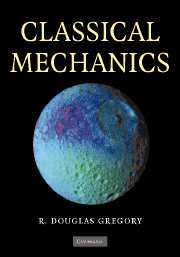Book contents
- Frontmatter
- Contents
- Preface
- 1 Newtonian mechanics of a single particle
- 2 Multi-particle systems
- 3 Analytical mechanics
- 4 Further topics
- 15 The general theory of small oscillations
- 16 Vector angular velocity and rigid body kinematics
- 17 Rotating reference frames
- 18 Tensor algebra and the inertia tensor
- 19 Problems in rigid body dynamics
- Appendix Centres of mass and moments of inertia
- Answers to the problems
- Bibliography
- Index
18 - Tensor algebra and the inertia tensor
Published online by Cambridge University Press: 05 September 2012
- Frontmatter
- Contents
- Preface
- 1 Newtonian mechanics of a single particle
- 2 Multi-particle systems
- 3 Analytical mechanics
- 4 Further topics
- 15 The general theory of small oscillations
- 16 Vector angular velocity and rigid body kinematics
- 17 Rotating reference frames
- 18 Tensor algebra and the inertia tensor
- 19 Problems in rigid body dynamics
- Appendix Centres of mass and moments of inertia
- Answers to the problems
- Bibliography
- Index
Summary
KEY FEATURES
The key features of this chapter are the transformation formulae for the components of tensors and tensor algebra; the inertia tensor and the calculation of the angular momentum and kinetic energy of a rigid body; and the principal axes and principal moments of inertia of a rigid body.
We have previously regarded a vector as a quantity that has magnitude and direction. Picturing a vector as a line segment with an arrow on it has helped us to understand essentially difficult concepts, such as the acceleration of a particle and the angular momentum of a rigid body. Neither of these quantities has any direct connection with line segments, but the picture is a valuable aid nonetheless. Useful though this notion of vectors is, it is not capable of generalisation and this is the main reason why we will now look at vectors from a different perspective. In reality, what we actually observe are the three components of a vector, and the values of these components will depend on the coordinate system in which they are measured. However, a general triple of real numbers {υ1, υ2, υ3}, defined in each coordinate system, does not neccessarily constitute a vector. The reason is that the components of a vector in different coordinate systems are related to each other (in a way that we shall determine) and, unless the quantities {υ1, υ2, υ3} satisfy this transformation formula, they are not the components of a vector.
- Type
- Chapter
- Information
- Classical Mechanics , pp. 492 - 521Publisher: Cambridge University PressPrint publication year: 2006

